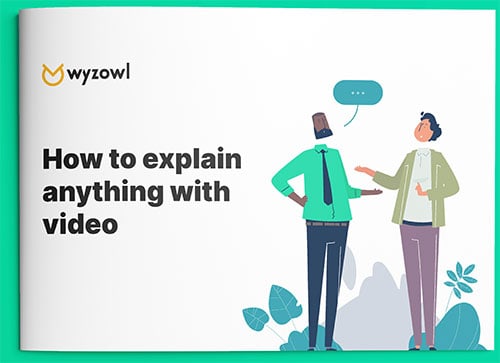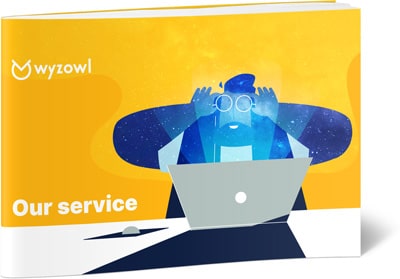Last updated on 24th August 2022
In this article we’re going to look at how to use video storytelling for your brand.
It’s no exaggeration to say that storytelling goes all the way back to the origin of our species. In his book Sapiens, which analyses and explains how human culture has evolved over millennia, Yuval Noah Harari states:
“Homo sapiens is a storytelling animal that thinks in stories rather than in numbers or graphs, and believes that the universe itself works like a story, replete with heroes and villains, conflicts and resolutions, climaxes and happy endings.”
So it makes sense that stories are exactly what’s going to help potential and existing customers build a stronger connection with your brand.
With that being said, let’s take a look at everything you need to know about how to use video storytelling for your brand…
What is video storytelling?
Storytelling is the action of telling stories. Therefore, video storytelling is the action of telling stories through video.
It’s safe to say that video is one of the primary ways we tell stories in today’s world, whether it’s a new bingeable TV show or an explainer video.
The main reason for this is that video is engaging. It captures more of our senses than just reading or listening alone, allowing viewers to experience a deeper sense of escapism and more connection with the characters in the story – because they can see them.
How to make a storytelling video
1. Identify your target audience
Before getting started it’s important to know exactly who you want to target with your video. After all, different people will respond to different stories.
The obvious demographic to target here is your ideal customer so be sure to do extensive research on those personas before you get started.
2. Identify your goal
In addition to knowing your audience, you also need to know exactly what you want your video to achieve.
Perhaps you want your video to raise brand awareness and target new customers. Or maybe you want to focus on how much you appreciate your current customers, to evoke a sense of loyalty and encourage repeat business.
Once you know your goal and your audience you’ll be able to move ahead with confidence.
3. Decide on a video format
There are many different video formats that you can choose from when it comes to marketing your brand, but for storytelling videos you’re likely going to want to stick with either animation or live action.
Animation, like live action is perfect for storytelling because it allows you to present characters that your audience can identify with and feel a connection to.
It probably won’t surprise you to know that at Wyzowl we prefer animation over all other video formats!
Professionally crafted animation gives you the power to create any kind of story you want, regardless of budget! Want to show hamsters travelling through space? You got it – without the huge costs of an animal wrangler and CGI!
Silliness aside, animation gives you total control. You can control the scenery, character design, colours, and more, without worrying about hiring the right actor or scouting for the best shooting location.
Plus, animation doesn’t just mean ‘cartoons’, it’s an extremely versatile medium. Check out this article to find out more: 6 Types of Animation Used by Brands
4. Gather inspiration
It’s important to watch other videos, both by your competitors and by other industry leaders, so that you can understand what works and what doesn’t.
This is also a great activity because it can help you to understand the best way to get your message across. Look to the big, successful brands for this – like Red Bull, for example.
Everyone knows that Red Bull is an energy drink but the stories they tell in their videos never focus on this. Instead they focus on extreme sports and pushing limits. Here’s an example:
Videos like this are captivating, and while there’s no direct link to Red Bull in the story, it definitely helps to create a link in viewers’ minds between the energy drink and achieving the impossible.
The same goes for Nike. Nike ads never say things like “Buy our products and you’ll be a better athlete”. Instead, they tell emotionally hard-hitting stories and show athletes overcoming obstacles (while wearing Nike) to make viewers feel inspired.
Video storytelling is really all about how you make viewers feel, and that’s a great thing to remember as we move onto step 4!
But, before moving onto that, if you’re stuck for where to start when looking for video inspiration then check this out our huge list of amazing explainer videos.
5. Write an amazing script
The renowned director Alfred Hitchcock once said: “To make a great film you need three things: the script, the script, and the script.”
And we think the same can be applied to a great brand video!
If you want to create a storytelling video for your brand then you need to put a lot of work into the script. The script should be your roadmap for everything that happens in the video. It should have a gripping beginning, an engaging middle, and end with a strong call to action.
Don’t be afraid to spend most of your creative time at the script stage! Once you iron out the script, the rest will follow.
Not sure where to start? Start here: How to Write a Video Script (Template Included)
6. Pay attention to the little details
The smallest, seemingly most insignificant things can really elevate your storytelling and take your video to the next level.
Make sure you consider everything from pacing (Is the story going too fast? Too slow?) to framing (What can you see in the frame? What does it add to the story?), and everything in between.
Music and voiceover can be huge differentiating factors for brand videos. Ensure you use a professional voiceover that reads your script with the right energy and speaks directly to your target audience. Similarly, make sure you use a soundtrack that adds to the storytelling rather than detracting from it.
10 Important video storytelling tips
1. Connect with your viewers’ emotions
Videos that viewers can connect with on an emotional level are likely to be more memorable and make more of an impact.
This doesn’t necessarily have to be tugging on the heart strings. Humour is also a strong emotion that can grab – and keep! – the attention of viewers. Ryan Reynolds’ ads for Aviation Gin are a great, quick example of videos that hit viewers’ funny bones with a unique brand of comedy that his audience finds familiar and maybe even comforting:
There’s also data to back up the success of emotional content. According to IPA, ads with purely emotional content perform twice as well than those with only rational content.
2. Show, don’t tell
This is a standard rule for any visual content. You have lots of amazing tools at your disposal: colours, camera angles, interesting fonts, graphics, and animations – use all of those tools to tell your story, not just words.
At Wyzowl, our script document is split into 2 columns: Voiceover and Action on Screen. Writing videos in this way is a great tool for always remembering to show rather than tell. For example, if you spot that you’ve mentioned something in both columns then maybe you realise you can remove it from the voiceover and simply show it on screen instead.
In addition to being a good video storytelling technique, this also helps you to keep your videos from becoming too long – something that’s extremely important with the shrinking attention spans of today’s audiences.
3. Make sure there’s a beginning, middle, and end
This is storytelling 101. All stories should have a beginning, a middle, and an end – preferably a happy one! And if you can throw in a twist, even better!
Here’s a solid example from IKEA:
This video begins with a robot deciding it wants to do its part to save the planet. The middle of the video shows the robot trying a lot of different things and failing. Then the video ends happily as the robot arrives home and we see all of the positive changes it has made at home, thanks to IKEA.
It’s important to have the beginning, middle, and end of your story plotted out before you begin making your video. A solid script and/or storyboard will give you a great roadmap to follow and make sure your video ends up exactly as you imagined it!
4. Give viewers someone to root for
The IKEA video above also ticks this box. Giving viewers someone to root for – a protagonist in the story – will ensure they’re more invested so that you can capture their attention and keep hold of it until your call-to-action appears at the end of the video.
Oftentimes, it helps if the ‘someone’ your viewer is rooting for represents them in some way. If viewers can see themselves in your character then they will be more likely to identify with their story and hopefully feel more connected to your brand!
5. Don’t forget about the little touches
While the story is the most important part of your video, you must also remember to include all of the little touches. We’re talking things like background music, special effects, micro animations (like a character blinking or raising their eyebrows) – all of these little details will help your video stand out from the crowd.
To demonstrate how important this is, take a look at the video below and pay attention to the sound effects:
Now here it is without sound effects:
Those tiny details can make such a difference!
6. Keep it snappy
This tip is pretty straight-forward. Attention spans are getting shorter and shorter, and so are brand videos. Some video ads are now just 6 seconds long!
Perhaps it’s a bit too difficult to tell a story in just 6 seconds but we think 60-90 seconds is the sweet spot. And there’s data to back this up. According to Wistia, viewer engagement remains steadily at 70% until around the 2 minute mark, at which point it drops off significantly. So, always remember, shorter is better!
7. Make it branded
When making a storytelling video, the story has to be the star of the show. However, that doesn’t mean you can’t allude to your brand in many different ways throughout the telling of the story.
One way to do this is to use your brand colours. Use them in the background, on character clothing, basically in as many places as possible. Here’s a solid example from Grammarly:
As you can see, the Grammarly green colour features in several places throughout. In addition to that, their logo remains on screen at all times in a subtle way that’s not detracting from the story.
8. Add an element of surprise
If you really want your video storytelling to go that extra mile, then add an element of surprise.
This could be something that will delight viewers, keep them on their toes, or make them laugh out loud.
There’s no real formula for how to do this. The best thing to do is watch as many amazing brand videos as you can to gather inspiration and start thinking about ways that you can break the mould.
Here’s a brilliant example from Dreamies:
9. Make it thought provoking
Another direction you could go in is making your video thought provoking. This can help your video to stay in the mind of viewers long after they’ve watched it. It can also encourage people to talk about and share your video, increasing brand awareness.
Here’s an example from Greenpeace:
This story is definitely thought provoking and it got a lot of tongues wagging when it was first released. It was sadly even banned from TV in the UK for breaching political advertising rules.
However, this storm of controversy actually increased the publicity of the video and helped it reach more than 30 million online views.
10. Don’t forget about promotion
Just as Alfred Hitchcock said the most important component of any film is the script, the script, the script; we’re sure that if he was around today and in marketing he would say the most important thing you can do for your video is promote, promote, promote!
There’s no point putting all of your effort, time, and money into creating an amazing storytelling video if no one is going to see it.
So, when you have your video and you’re ready to release it to the world, be sure to push it on as many different platforms as you can.
Take a look at this article to find out how to get started: REVEALED! 17 Powerful Video Marketing Promotion Strategies.
5 Amazing storytelling videos to inspire you!
1. John Lewis
It’s kind of impossible to write an article about video storytelling and not mention at least one John Lewis Christmas ad.
This Edgar the Dragon video (a collaboration with Waitrose) went viral almost immediately after it was posted – and for good reason. This is a heart-warming story about a dragon that can’t contain its excitement for Christmas. The only trouble is, when Edgar gets excited he spurts fire from his nostrils and causes calamities wherever he goes!
It may not look like John Lewis was advertising anything in particular here, but the inclusion of a cute character in their video created a lot of revenue potential. Soon after the ad was released, several ‘Excitable Edgar’ products went up for sale and were very well received by the public!
2. Budweiser
For many years now, Budweiser ads have followed a similar pattern. They star either a horse or a dog, or both (like the example above) and they tug on viewers’ heartstrings.
The stories told in Budweiser ads like this one stay with viewers long after they’ve been watched, and they certainly have more of an impact than a video that simply lists the reasons to buy the product.
Budweiser are masters of ‘show, don’t tell’. Their product is about getting together with friends and forming lasting bonds. What better way to show that than with two animals that humans have had a strong connection with for thousands of years?
3. Virgin Voyages
Some brands, like Budweiser, capture attention through a heart-warming story. Others, like Virgin Voyages, go straight for the funny bone.
This hilarious brand video tells the story of an adult-only cruise from the perspective of the children that are left behind at home. It features an original song and is shot like an 80s music video, making it both entertaining and shareable.
According to our Video Marketing Statistics 2022, people are twice as likely to share video content with their friends than any other type of content.
4. Wimbledon
This beautiful animation showcases the history of tennis at Wimbledon. Animation was the perfect choice for this story because the versatility of the medium allows the video to seamlessly take the viewer through different eras.
The music in this video also works hard to create emotion. The soundtrack is inspiring and increases in volume as the video ends with an incredible image of an animated Serena Williams reaching up and returning a shot directly to the camera.
The number of famous faces able to appear in this video is also another win for animation – imagine the enormous cost and organisation it would take to get all of those tennis players in one place to shoot this video!
5. Airbnb
Despite having over 150 million people using Airbnb to book a holiday rental, the idea can still be a little alien for some. When Airbnb started it was a trailblazer in the industry. No company had ever created a model where homeowners could let out their places as holiday rentals, so it’s not that surprising that some people still don’t like the idea of ‘strangers’ in their home.
This video gently pokes fun at that by showing monsters arriving at someone’s home. Then, as the video progresses the monsters become less scary and finally, as they leave, they transform into a human family. The video ends on the tagline: ‘Strangers aren’t that strange.’
Final thoughts
Storytelling is a powerful tool that can really elevate your video marketing efforts, encouraging more people to watch and share your videos, convert into customers, and maybe even become lifelong followers of your brand.
For more video storytelling inspiration check out this article: 20 of the Best Video Storytelling Examples EVER.






